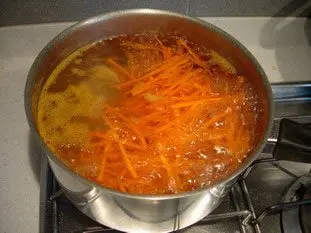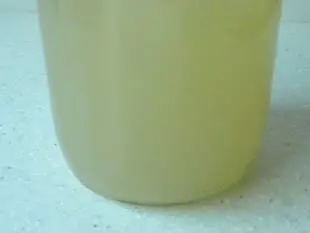This site uses only a few technical cookies necessary for its operation. By continuing to browse, you accept their use.
To find out more...
To find out more...
Perpetual stock

It's something you have probably have done yourself: cooked or pre-cooked vegetables before adding them to a recipe. This is almost always done the same way: peel the chosen vegetables (carrots, for example), cut them up, boil them in salted water (using a tablespoon or so of coarse salt per litre), then cool them rapidly in cold water to stop the cooking. They are then ready to use in the recipe.
31 K 5/5 (12 reviews)
Last modified on: November 22th 2016
Perpetual stock
This very simple way of cooking (the French call this “English style” ) not only cooks the vegetables, but leaves us with something else: a vegetable stock. As they cook, the vegetables release some of their flavour into the water. So, if you have several different kinds of vegetables to cook the same way, you will end up with an excellent stock which is far too good to throw away! To make use of it, simply let it cool, then filter it into a bottle (or other container) with a lid that seals well and keep it in the fridge.
Next time you need to boil vegetables again, instead of using a pan of fresh water, re-use your stock, and your vegetables will taste even better (add more water and/or salt if necessary).
Each time you repeat the operation, the richer and more flavoursome your stock will become. This doesn't only work with vegetables; you can use it to cook meat as well – which will improve your stock even further with a stronger flavour.
A few guidelines:
- If you are poaching seafood, the flavours are distinctive, so it is better to keep a separate stock on the go, rather than mix “surf” (vegetables + fish or shellfish), and “turf” (vegetables + meat).
- Even in the fridge, the stock won't keep very long, so if you do not use it within the next week to 10 days, either freeze it or boil it up again on its own.
- When you are making soup, use your stock rather than plain water (or top up with water) – you will be amazed at the difference in flavour.
- If you boil potatoes in the stock, peel them first, as the skins will do nothing for the flavour, other than add an unpleasant “earthy” taste.
- If you are making stock for the first time, you don't need to start it from scratch. Add ½ an onion (peeled) to the salted water and, if possible, a bouquet garni, or at least a handful of leek greens and a spring of thyme to give it a head start. Even better, you can start by making a more sophisticated version, a real vegetable stock.
- Don't be too quick to condemn commercially available stock cubes – they are practical and can be a good way to start a perpetual stock, especially if they are organic, but do check the label carefully to see what is in them.
To sum up: Do not throw away cooking water used to boil vegetables or poach fish or meat - this is no longer just water; it is now a delicious stock that can be perpetually reused and added to: the ultimate in kitchen recycling.
Stock (or bouillon) has long been a cornerstone of French cuisine. It is worth remembering that to the French, “bouillon” is a familiar term for a basic popular eatery. Back in the 17th and 18th centuries, in the streets of Paris and other large towns, there were little shops or stalls known as “marmites perpétuelles” (perpetual pots) where huge cauldrons containing a bouillon of vegetables and meats (mostly poultry), simmered away day and night over low fires, and from which one could buy a bowlful at any hour of the day. Each time a bowlful was served, more water was added to the pot and more vegetables and meat were added to replace what was taken out. After all those hours of slow cooking, the resulting mixed broth had a robust and quite unique flavour.

Next time you need to boil vegetables again, instead of using a pan of fresh water, re-use your stock, and your vegetables will taste even better (add more water and/or salt if necessary).
Each time you repeat the operation, the richer and more flavoursome your stock will become. This doesn't only work with vegetables; you can use it to cook meat as well – which will improve your stock even further with a stronger flavour.
A few guidelines:
- If you are poaching seafood, the flavours are distinctive, so it is better to keep a separate stock on the go, rather than mix “surf” (vegetables + fish or shellfish), and “turf” (vegetables + meat).
- Even in the fridge, the stock won't keep very long, so if you do not use it within the next week to 10 days, either freeze it or boil it up again on its own.
- When you are making soup, use your stock rather than plain water (or top up with water) – you will be amazed at the difference in flavour.
- If you boil potatoes in the stock, peel them first, as the skins will do nothing for the flavour, other than add an unpleasant “earthy” taste.
- If you are making stock for the first time, you don't need to start it from scratch. Add ½ an onion (peeled) to the salted water and, if possible, a bouquet garni, or at least a handful of leek greens and a spring of thyme to give it a head start. Even better, you can start by making a more sophisticated version, a real vegetable stock.
- Don't be too quick to condemn commercially available stock cubes – they are practical and can be a good way to start a perpetual stock, especially if they are organic, but do check the label carefully to see what is in them.
To sum up: Do not throw away cooking water used to boil vegetables or poach fish or meat - this is no longer just water; it is now a delicious stock that can be perpetually reused and added to: the ultimate in kitchen recycling.
Stock (or bouillon) has long been a cornerstone of French cuisine. It is worth remembering that to the French, “bouillon” is a familiar term for a basic popular eatery. Back in the 17th and 18th centuries, in the streets of Paris and other large towns, there were little shops or stalls known as “marmites perpétuelles” (perpetual pots) where huge cauldrons containing a bouillon of vegetables and meats (mostly poultry), simmered away day and night over low fires, and from which one could buy a bowlful at any hour of the day. Each time a bowlful was served, more water was added to the pot and more vegetables and meat were added to replace what was taken out. After all those hours of slow cooking, the resulting mixed broth had a robust and quite unique flavour.
Lasts posts
Butter vs. grease
We often read in a recipe where a pastry is put into a mould that, just before pouring, the mould should be buttered or greased. But what's the difference between these 2 terms?December 1st 20256735
Getting out of the fridge early
Very often when you're cooking, you need to take food or preparations out of the fridge, to use them in the recipe in progress. There's nothing tricky about this: you just take them out of the fridge and use them, usually immediately, in the recipe. But is this really a good method?November 24th 20259665
Who's making the croissants?
When you look at a bakery from the outside, you naturally think that in the bakery, the bakers make the bread, and in the laboratory, the pastry chefs make the cakes. It's very often like that, with each of these professions having quite different ways of working, but sometimes there's also one...November 23th 2025867
Oven height
When we put a dish or cake in the oven, we naturally tend to put it on the middle shelf, and that's what we usually do. But in some cases, this position and height can be a little tricky, so let's find out why.October 8th 20252,4605
The importance of sieving
In recipes that use a fine powder (flour, powdered sugar, etc.), you'll often see the advice to sift before using it. To sift is to pass the powder in question through a sieve (a very fine strainer) before incorporating it into your recipe. It's often advice, but is it really useful?September 3rd 20257,3433
Other pages you may also like
Well-cooked meat
Have you ever noticed that if you like your meat well done, it invites strange looks? For instance, in a restaurant, when asked “How would you like that cooked?” If you reply, “Well done,” it is almost as if you are swearing….May 21th 201134 K 14.4
The window-pane test in bread-making
The home bread-makers often ask themselves “Have I kneaded my dough long enough?” . A good question, as dough that is insufficiently kneaded will not rise properly or will fall flat when the top is slashed, which is very frustrating. To know when the dough is ready, one can rely on the length...June 16th 202196 K 23.9
Drawing a pattern in pastry
Often in the kitchen, in pastry-making, or in baking, we need to trace a pattern on a pastry. It's just a question of aesthetics but it has its effect after baking on a galette, pithiviers, pâté en croute (terrine in a pie crust), etc.May 23th 201935 K4.1
Fruits and their syrup
As I write these lines, we are finally in the summer, the holidays are approaching, and above all, the fruits are pouring onto the market stalls, if they are ripe, it's time to enjoy them to the full! .July 24th 201911 K4.7
How to break eggs properly?
It is a very common gesture in pastry, bakery and of course cooking: breaking eggs to incorporate them into a recipe. You have eggs (which professionals call "shell eggs" to differentiate them from liquid eggs in cartons or cans), and you must break them to incorporate the contents into your...June 26th 202115 K4.8
Post a comment or question
Follow this page
If you are interested in this page, you can "follow" it, by entering your email address here. You will then receive a notification immediately each time the page is modified or a new comment is added. Please note that you will need to confirm this following.
Note: We'll never share your e-mail address with anyone else.
Alternatively: you can subscribe to the mailing list of cooling-ez.com , you will receive a e-mail for each new recipe published on the site.









